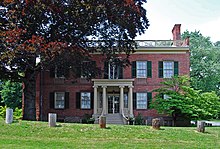Abraham Ten Broeck
Abraham Ten Broeck | |
|---|---|
Johannes Jacobse Beeckman | |
| Member of the New York Provincial Congress | |
| In office 1775–1777 | |
| Personal details | |
| Born | 13 May 1734 Federalist |
| Spouse |
Elizabeth Van Rensselaer
(m. 1773) |
| Children | 5, including Stephen Van Rensselaer II (brother-in-law) |
| Residence | Prospect |
| Rensselaerswyck series | |
|---|---|
| Dutch West India Company | |
| The Patroon System | |
| Map of Rensselaerswyck | |
| Patroons of Rensselaerswyck:
Stephen van Rensselaer III (1784–1839) | |
 |
Abraham Ten Broeck (May 13, 1734 – January 19, 1810) was a
Early life
Abraham Ten Broeck was the son of
His father was a prominent merchant and politician who served as Albany's mayor beginning in 1746. His paternal grandfather Wessel Ten Broeck, was the son of former Albany mayor
Career
Abraham was sent to New York City to learn business with his sister Christina's husband, Philip Livingston. In 1751, at seventeen years old,[4] he was sent to Europe to learn international business after his father's death, returning to Albany in 1752.[2]
Ten Broeck increased his wealth via trade while in Albany. During the 1750s, he was involved in the provincial militia. In 1759, he was elected to the Albany City Council and in 1760, he was elected to the Province of New York Assembly while continuing to serve Albany.[4]
In 1769, his brother-in-law died at age 27 and Ten Broeck was named co-administrator of the Manor of
American Revolution
Ten Broeck continued his military involvement and was named colonel of the
He was a member of the
After war years
After the death of Mayor
Ten Broeck was a
Personal life

In November 1763, he married Elizabeth
- Elizabeth ten Broeck (1772–1848), who married Rensselaer Schuyler (1773–1847), a son of Philip Schuyler and Catherine Van Rensselaer, and the younger brother of Angelica Schuyler Church, Elizabeth Schuyler Hamilton, Peggy Schuyler Van Rensselaer, and Philip Jeremiah Schuyler.
- Margarita ten Broeck (1776–1812), who died unmarried.[10]
By the mid-1760s, Ten Broeck was one of Albany's wealthiest men. The Ten Broecks lived in a house that was assessed equally with the Schuyler Mansion and Yates Mansion in 1788. In 1797, it was burned in a fire that destroyed several city blocks.[11] Construction was started on the new home soon after, and the family resided there beginning in 1798 calling the place "Prospect". The historic mansion still stands in Arbor Hill more than 200 years later.[12]
Ten Broeck died on Friday, January 19, 1810.[13]
Legacy
The towns of
See also
- Manor of Rensselaerswyck
References
- ^ Spooner 1907, p.17
- ^ a b c d e Bielinski, Stefan. "Abraham Ten Broeck". exhibitions.nysm.nysed.gov. New York State Museum. Archived from the original on 11 March 2018. Retrieved 12 September 2017.
- ^ a b Reynolds, Cuyler (1911). Hudson-Mohawk Genealogical and Family Memoirs: A Record of Achievements of the People of the Hudson and Mohawk Valleys in New York State, Included Within the Present Counties of Albany, Rensselaer, Washington, Saratoga, Montgomery, Fulton, Schenectady, Columbia and Greene. Lewis Historical Publishing Company. p. 32. Retrieved 12 September 2017.
- ^ a b c d "Abraham Ten Broeck". www.newnetherlandinstitute.org. New Netherland Institute. Archived from the original on 12 September 2017. Retrieved 12 September 2017.
- ^ "A New Nation Votes". elections.lib.tufts.edu. American Antiquarian Society | Digital Collections and Archives at Tufts University. Archived from the original on 27 July 2016. Retrieved 12 September 2017.
- ^ "Elizabeth van Rensselaer (Mrs. Abraham) ten Broeck (1734-1813)". www.albanyinstitute.org. Albany Institute of History & Art. Archived from the original on 13 September 2017. Retrieved 12 September 2017.
- ^ Bielinski, Stefan. "Elizabeth van Rensselaer ten Broeck". exhibitions.nysm.nysed.gov. New York State Museum. Archived from the original on 4 May 2017. Retrieved 12 September 2017.
- ^ Bielinski, Stefan. "Cornelia Stuyvesant Ten Broeck". exhibitions.nysm.nysed.gov. New York State Museum. Archived from the original on 17 February 2017. Retrieved 12 September 2017.
- ^ Daughters of the American Revolution (1898). Lineage Book Daughters of the American Revolution. The Society. p. 283. Archived from the original on 23 September 2022. Retrieved 12 September 2017.
- ^ Bielinski, Stefan. "Margarita ten Broeck". exhibitions.nysm.nysed.gov. New York State Museum. Archived from the original on 9 January 2017. Retrieved 12 September 2017.
- ^ Fire Archived 2007-09-15 at the Wayback Machine at the New York State Museum web site.
- ISBN 9780486301259. Archivedfrom the original on 23 September 2022. Retrieved 12 September 2017.
- ^ Munsell, Joel (1854). The Annals of Albany. Albany, New York: J. Munsell Co. Retrieved 12 September 2017.
